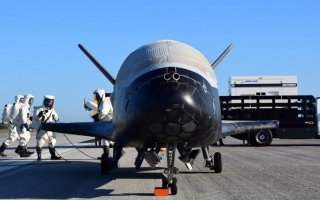X-37B: A 'Space Bomber' Russia and China Must Fear (Or Something Else)?
As tensions continue to escalate between Beijing and Washington, the potential militarization of space becomes a more possible prospect. While the U.S. works to improve the capabilities of the X-37B, China is undoubtedly ramping up its own efforts to achieve its own sophisticated spaceplane.
Meet the X-37B - In the latest iteration of the Pentagon’s National Defense Strategy, China is cited as America’s “pacing military threat,” rather than just a “global competitor.”
Released in January, the report detailed the People’s Republic of China’s agenda to become the world’s leading nuclear and conventional military power.
Additionally, Beijing is working hard to develop its space capabilities. According to the report, the PRC has tested at least two uncrewed spaceplanes, the Shenlong and the Tengyun, over the last year. The Pentagon believes these spaceplanes were designed to go head to head with America’s own experimental space platform, the X-37B.
A brief history of America’s experimental spaceplane
NASA originally selected Boeing Integrated Defense Systems to create an orbital vehicle back in the late 1990’s. The aerospace giant continues to provide program management, engineering, test and mission support for the program from its sites across the country. Over a four year-long period, NASA, the U.S. Air Force and Boeing contributed nearly $200 million to the spaceplane project. By 2002, Boeing was awarded as part of NASA’s Space Launch Initiative framework to develop the prototype. While NASA’s initial goal of possessing an Orbital Vehicle never came to fruition, the X-37B has proven to be a very successful robotic space vehicle.
Most of the X-37B’s technologies derived from the X-37A vehicle. This model was used as a test glider and lacked a propulsion system. As outlined in an earlier 19FortyFive piece, “The current iteration of the X-37B incorporates many technological advancements including all electro-mechanical flight controls, eliminating the need for flammable hydraulics, advanced avionics to automate de-orbit and landing, a lightweight composite structure, and novel materials designed to improve heat resistance.” The X-37B is nearly 30 feet long with a height of roughly nine feet. It has a launch weight of 11,000 pounds and a wingspan measuring at just over 14 feet long. In 2010, the X-37B was launched into space for the first time, strapped to the top of an Atlas V rocket.
How OTV-6 made history
The U.S. military’s X-37B made history last year when it touched down at NASA’s Kennedy Space Center after spending 908 days in orbit. During its time in space, the Orbital Vehicle-6 (OTV-6) was the first mission to introduce a service module- a ring component that was attached to the rear of the vehicle and enabled more experiments while in orbit. The uncrewed spacecraft is boosted into space by a launch vehicle and then re-enters Earth by landing as a spaceplane.
While many details surrounding the experimental X-37B remain a mystery, some analysts have speculated the spaceplane’s probable future mission sets. According to Popular Mechanics, “The X-37B could allow the Air Force to test technologies bound for the next generation of spy satellites, before building a billion dollar satellite around them, and returning them to study after long missions in space. The X-37B could also allow such technologies to be used early, in case of a crisis or emergency on the ground.”
As tensions continue to escalate between Beijing and Washington, the potential militarization of space becomes a more possible prospect. While the U.S. works to improve the capabilities of the X-37B, China is undoubtedly ramping up its own efforts to achieve its own sophisticated spaceplane.
Maya Carlin is an analyst with the Center for Security Policy and a former Anna Sobol Levy Fellow at IDC Herzliya in Israel. She has by-lines in many publications, including The National Interest, Jerusalem Post, and Times of Israel.
Image: Creative Commons.


